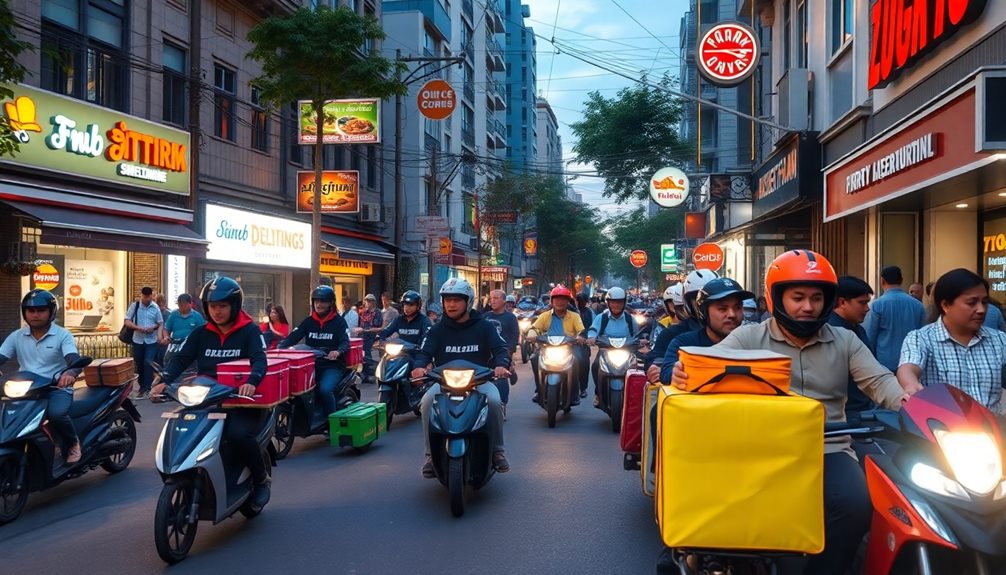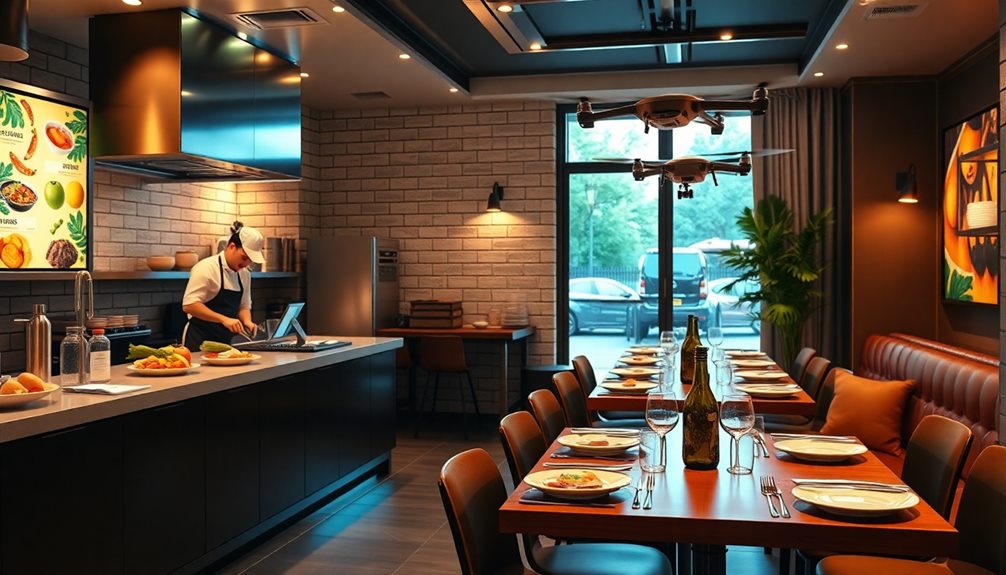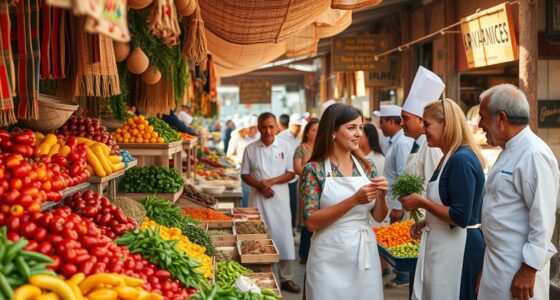The restaurant delivery scene is booming, valued at $26 billion and growing at 10% annually. You're not alone in preferring delivery; about 70% of consumers ordered takeout recently. Millennials and Gen Z especially drive this trend, often searching for new places through apps. You might also enjoy the rise in alcohol delivery, as many are opting for drinks delivered to their door. Sustainability is becoming essential too, with restaurants adopting eco-friendly practices. As these trends continue evolving, you'll want to stay updated on how they affect your dining choices and experiences.
Key Takeaways
- The U.S. food delivery market is valued at $26 billion in 2023 and projected to grow at 10% annually through 2026.
- 70% of U.S. consumers placed delivery orders in the past month, highlighting its essential role in dining choices.
- Millennials and Gen Z significantly influence restaurant preferences, with 67% ordering from new eateries in early 2024.
- The rise of ghost kitchens caters to delivery demand, reducing overhead and focusing solely on off-premise dining.
- Sustainability initiatives, such as eco-friendly packaging, are increasingly prioritized by restaurants to meet consumer demand for guilt-free dining.
Overview of Food Delivery Trends
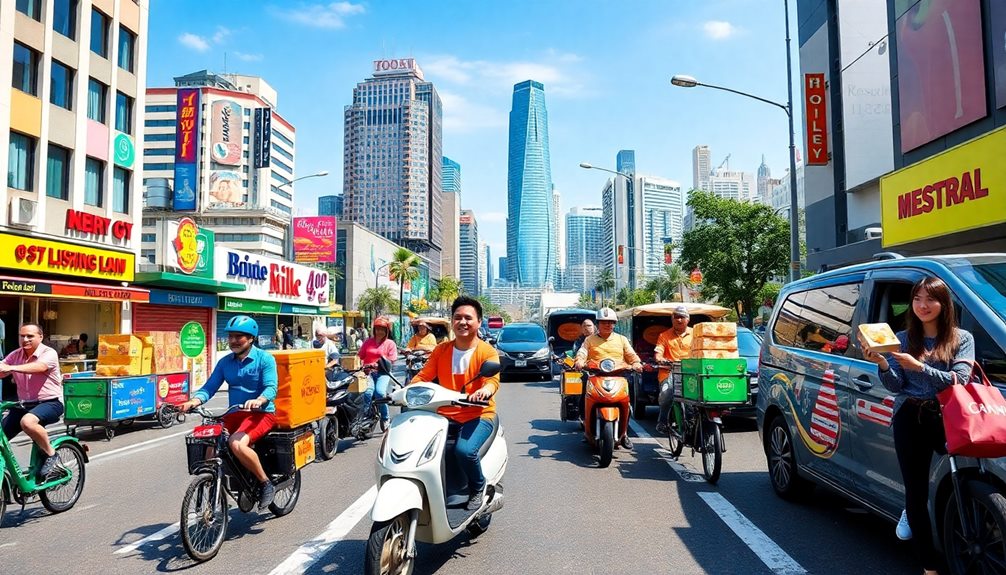
As consumer preferences shift towards convenience and variety, the U.S. food delivery market has exploded, reaching a valuation of $26 billion in 2023.
You're part of a growing trend, with approximately 70% of U.S. consumers placing delivery orders in the past month. This surge in demand highlights how off-premise dining options are becoming crucial for many.
Younger demographics, particularly those aged 18-34, are driving this movement, accounting for 50% of delivery orders. Their preferences are reshaping the food landscape, pushing restaurants to adapt quickly.
Third-party apps have become the go-to choice for 51% of consumers, thanks to their convenience and user-friendly interfaces.
As restaurants seek to meet these evolving consumer preferences, the rise of ghost kitchens has emerged as a strategic response.
These innovative setups allow eateries to operate without the traditional overhead costs associated with dining spaces, enabling them to focus on fulfilling delivery orders efficiently.
With the food delivery market projected to grow at a rate of 10% annually through 2026, it's clear that this trend isn't slowing down anytime soon.
Embracing these changes is essential for both consumers and restaurant owners alike.
Consumer Preferences in Delivery
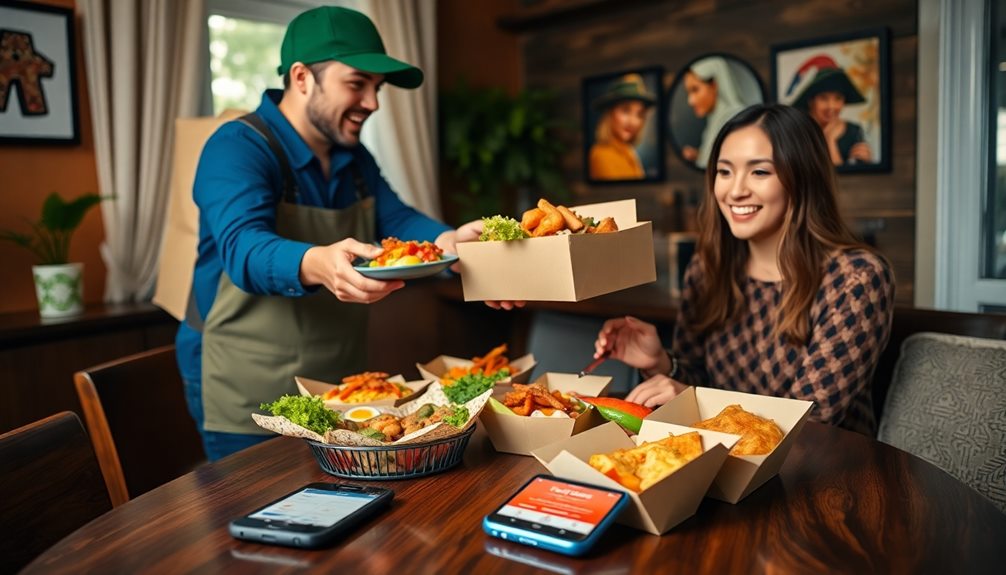
Food delivery has become a staple for many, with 52% of U.S. consumers considering it essential to their dining experience. This trend is particularly strong among younger generations, as 67% of Millennials and 63% of Gen Z prioritize delivery in their meal choices.
You might find that convenience is a top factor influencing your consumer preferences; 51% of people prefer using third-party apps for their delivery needs, thanks to their user-friendly interfaces.
Familiarity also plays a significant role in your ordering habits. About 56% of diners tend to stick with the same restaurant for takeout or delivery, showcasing a loyalty that nearly half of consumers express by ordering from their favorite spot weekly.
This loyalty reflects a comfort level that helps you make quicker decisions when hunger strikes.
If you're like many others, you might notice that the peak time for food delivery is around 6 PM, aligning perfectly with dinner.
This habitual ordering time illustrates how consumer preferences are shaped by lifestyle and convenience, making online ordering an integral part of your dining experience.
Alcohol Delivery Insights
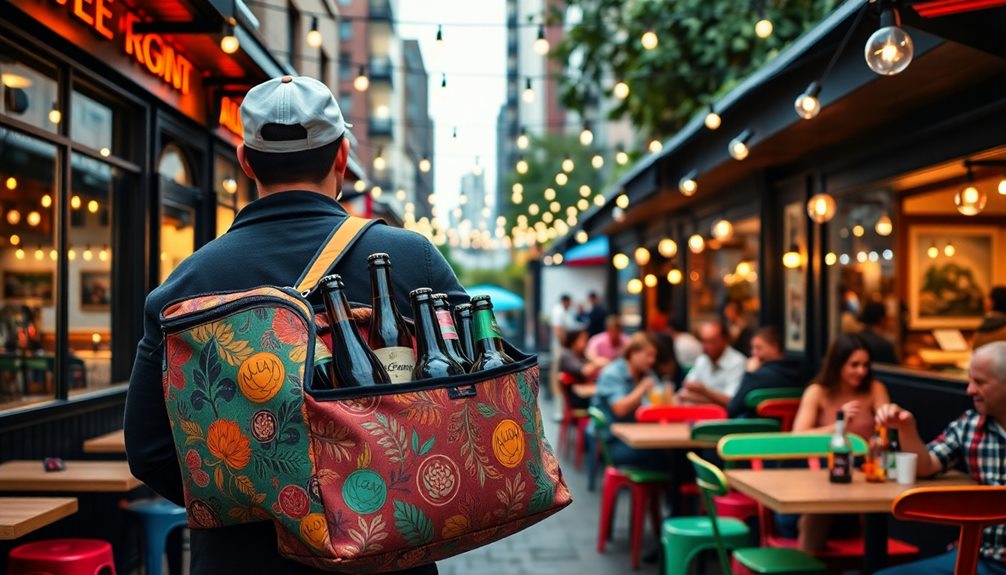
Transforming the way you celebrate, alcohol delivery has surged in popularity, with 52% of U.S. consumers now treating themselves to a delivered drink. This trend reflects a notable increase in orders compared to last year, showing how integral alcohol delivery has become in your life.
Among your options, wine and champagne are the most popular choices when you decide to indulge.
Moreover, 39% of U.S. consumers like you choose alcohol delivery when hosting parties, making it a go-to solution for social gatherings. It's convenient and adds a festive touch to any occasion.
Beyond parties, alcohol delivery also serves as a thoughtful gifting option, with 21% of Americans ordering drinks for friends or loved ones.
This growing trend mirrors the overall rise in online food delivery, where 41% of U.S. consumers have increased their alcohol delivery orders compared to the previous year.
It's clear that alcohol delivery isn't just about convenience; it's about enhancing your experiences, whether you're celebrating a special moment or simply enjoying a quiet evening at home.
Restaurant Consumer Behavior
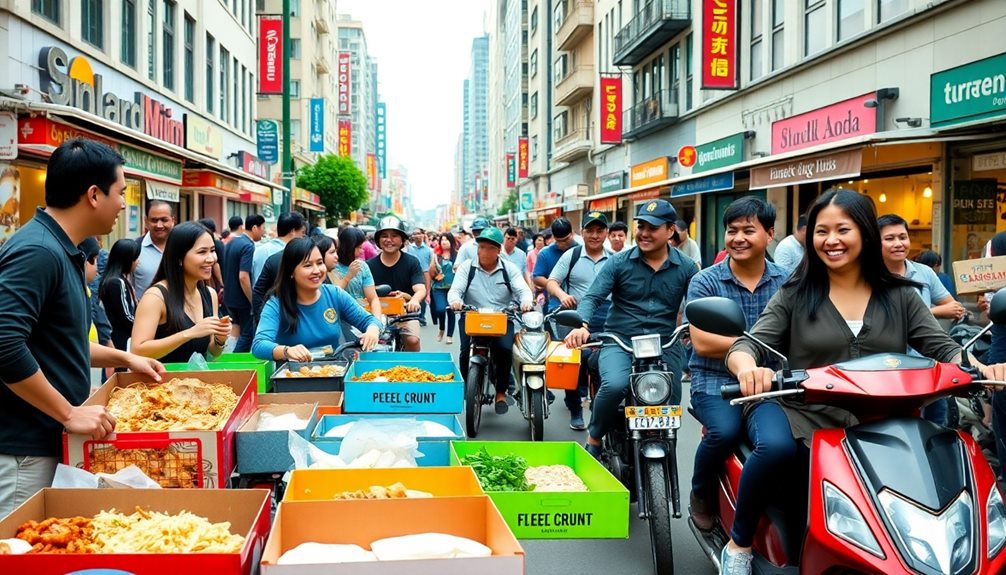
In today's fast-paced world, restaurant delivery has become a staple for many consumers. You might be one of the 70% of US consumers who ordered delivery in the past month, a trend echoed by 66% of Canadians. This shift in dining habits shows how essential convenience is in your decision-making.
When you choose to order food delivery, familiar restaurants often take precedence. About 56% of you prefer takeout from places you already know, highlighting a strong inclination towards comfort over trying something new.
Notably, younger consumers, including Millennials and Gen Z, account for a staggering 50% of all delivery orders. Your generation's preferences are shaping restaurant online ordering trends and driving innovation in the industry.
As you explore new dining options, value plays a key role. Around 42% of US consumers actively search for promotions or discounts when trying new eateries. This desire for good deals reflects a savvy approach to dining, ensuring you get the most out of your experience.
To summarize, your behavior as a consumer greatly influences how restaurants adapt and evolve in the delivery landscape.
Online Ordering Statistics
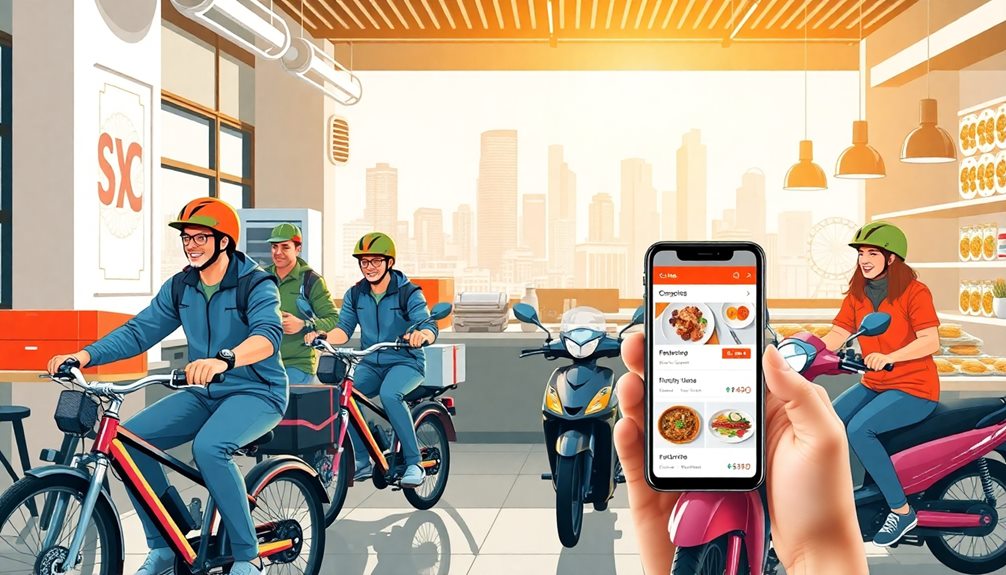
Many diners are turning to online ordering as their primary method for getting meals. In fact, 70% of US diners ordered delivery in the past month, showing just how essential online food services have become. It's not just about convenience; 51% of consumers use third-party apps to discover restaurants and place orders, making it their preferred way to order.
You'll notice patterns in ordering behavior, too. The peak time for food delivery is 6 PM, which suggests that many of you're looking for a quick and easy dinner solution after a long day. This trend isn't limited to the US; 66% of diners in Canada and Australia also reported ordering takeaway recently, indicating a global shift towards online ordering.
Moreover, the experience with delivery services is generally positive. In Houston, for example, the average star rating for delivery services is 4.0 out of 5. This reflects that you're not just relying on these services, but you're satisfied with the results.
With such strong statistics backing online ordering, it's clear this method is here to stay.
Pickup and Takeout Trends
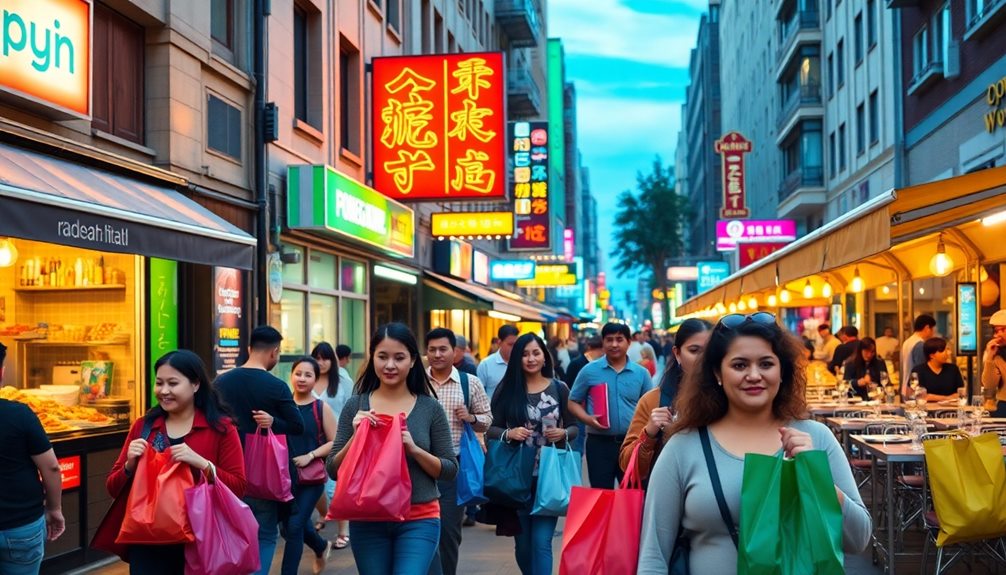
You're not alone if you've noticed a surge in takeout orders lately. With 70% of US consumers opting for takeout recently, it's clear that convenience drives this trend.
Additionally, many families are seeking efficient meal solutions, especially during times of financial strain, as seen in divorce situations where financial planning during divorce becomes essential.
Plus, the flexibility to choose between pickup and delivery makes dining out even easier for everyone.
Popular Pickup Preferences
With a significant portion of consumers embracing the convenience of takeout, popular pickup preferences are reshaping dining habits across North America and beyond.
Recent data shows that 70% of US consumers ordered takeout in the past month, while 66% in Canada also opted for this option. Furthermore, New Zealand saw a remarkable 78% growth in same-store pickup orders on DoorDash from 2022 to 2023.
This shift mirrors a broader trend in lifestyle choices, where people are increasingly valuing convenience and efficiency in their daily routines, akin to how astrological influences can shape personal preferences.
Here are three key trends driving this shift:
- Flexibility: Consumers appreciate the choice between pickup and delivery, allowing them to cater to their preferences and schedules.
- Quick Service: Many patrons prefer picking up their orders to reduce wait times and guarantee their meals are fresh and hot.
- Cost Efficiency: Avoiding delivery fees often makes takeout more appealing, especially for those mindful of their budgets.
As the food delivery industry evolves, these pickup preferences highlight a growing demand among consumers for convenient dining options.
Year-over-year growth in pickup orders, reported at 9% in the US and 4% in Australia, showcases the ongoing trend that's here to stay.
Growth in Takeout Orders
Takeout orders are on the rise, reflecting a shift in how consumers approach dining. Recent data shows that 70% of U.S. consumers ordered takeout in the past month, indicating a strong preference for off-premise dining options. Canadians are also engaged, with 66% having ordered takeout recently.
If you're a restaurant owner, this trend highlights an opportunity to cater to busy lifestyles that demand convenience. Additionally, seasonal events and holidays can influence dining preferences, similar to how SeaWorld operating hours adjust during peak seasons.
In New Zealand, same-store pickup orders on DoorDash grew by an impressive 78% from 2022 to 2023, showcasing the increasing popularity of pickup options. Consumers appreciate the flexibility to choose between takeout and delivery, which allows them to enjoy their favorite meals on their terms.
The surge in takeout orders is largely driven by the growing reliance on online ordering and mobile technologies. As you adapt to these trends, consider optimizing your menu for takeout and enhancing your online ordering system.
Flexibility in Dining Choices
As dining preferences evolve, many consumers are embracing flexibility in their meal choices, opting for both pickup and takeout options. Recent statistics reveal that 70% of US consumers ordered takeout in the past month, highlighting a strong desire for convenience.
In Canada, 66% of people are choosing pickup, while New Zealand saw a staggering 78% growth in same-store pickup orders on DoorDash from 2022 to 2023. This shift towards flexible dining options enhances your overall experience.
Here are three key reasons why flexibility in dining choices is gaining popularity:
- Convenience: You can choose between delivery food and pickup based on your schedule, making meals more accessible.
- Late-night cravings: There's been a surge in late-night orders, reflecting your demand for food outside traditional meal times.
- Variety: With takeout options, you can explore different cuisines without the need for reservations.
Embracing flexibility in dining choices not only satisfies your cravings but also adapts to your lifestyle. Whether you prefer the comfort of home or a quick pickup, the dining landscape is evolving to meet your needs.
Delivery App Preferences
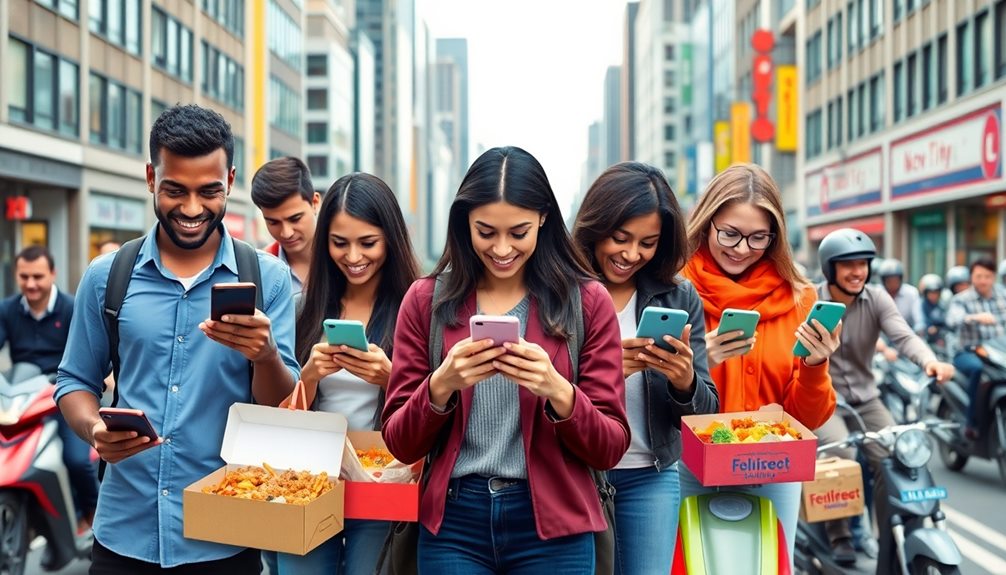
Convenience plays a pivotal role in shaping consumer preferences for delivery apps. You're likely among the 51% of US consumers who prefer using third-party apps for food delivery, as they streamline the ordering process and save you time.
With platforms like DoorDash leading the charge, it's clear that many people trust these services to deliver their meals quickly and efficiently.
In fact, 40% of US consumers order via third-party apps at least five times a month, illustrating a growing reliance on these platforms. You might find the user-friendly interfaces and attractive promotions offered by these apps particularly appealing, making your food delivery experience smoother and more enjoyable.
Interestingly, only 20% of consumers still choose to place orders over the phone, showing just how dominant app-based ordering has become.
As you navigate your options, consider how your delivery app preferences align with these trends. As technology continues to evolve, it's important to stay informed about the best third-party apps available.
After all, the right food delivery app can enhance your dining experience, providing you with the convenience you crave while enjoying your favorite meals.
Customer Engagement Across Generations

When it comes to engaging with restaurants, different generations have distinct preferences.
You'll notice that Millennials and Gen Z are more influenced by social media and actively participate in loyalty programs compared to older diners.
Understanding these trends can help you cater to each age group's unique approach to discovering and enjoying new dining experiences.
Generational Preferences in Engagement
Customer engagement in the restaurant delivery sector varies considerably across generations, highlighting distinct preferences and behaviors. For younger generations like Millennials and Gen Zers, convenience and digital interaction drive their choices, making them key players in the delivery landscape.
Here are three notable trends you should consider:
- Higher Engagement: Approximately 67% of Millennials and Gen Zers ordered from new restaurants in Q1 2024, showing their enthusiasm to explore delivery options.
- Social Media Influence: A significant 30% of Gen Zers discover new dining spots through TikTok, while 29% turn to Instagram, illustrating their reliance on social media for food choices.
- Loyalty Programs: Younger diners typically engage with an average of four loyalty programs, compared to just two for older generations, revealing a stronger interest in rewards and brand engagement.
With 50% of delivery orders coming from the 18-34 age group, it's clear that understanding these generational preferences is essential for restaurants looking to enhance customer engagement and adapt to evolving trends.
Social Media Influence Today
In today's digital landscape, social media plays a pivotal role in how diners discover new restaurants. For many, platforms like TikTok and Instagram are their first stops. In fact, 30% of Gen Zers use TikTok to find dining options, while 29% turn to Instagram. This shows just how influential social media is on the dining choices of younger generations.
When you're deciding where to order from, you're likely influenced by reviews on these platforms. A significant 46% of US diners rely on social media reviews, emphasizing the importance of an online reputation. User-generated content, particularly enticing food photography, also sways over a third of consumers in their restaurant selection process.
Additionally, 23% of Canadian Gen Zers find themselves trying new places based on social media influencers, further showcasing the impact of influencer marketing on dining habits.
However, older generations often lean towards traditional dining experiences, creating a clear divide in how each generation engages with digital platforms for discovering new restaurants.
Understanding these dynamics can help you navigate the ever-evolving landscape of food delivery and dining choices.
Loyalty Programs by Age
As loyalty programs evolve, they reveal significant differences in engagement among generations. You might notice that younger diners, particularly Millennials and Gen Z, are leading the charge with their loyalty habits.
These groups average four loyalty programs each, while older generations only manage about two. This disparity highlights just how involved younger consumers are with rewards and promotions.
Here are three key insights about loyalty programs across age groups:
- Promotions Drive Engagement: 42% of US consumers try new restaurants because of promotions, with younger diners actively seeking deals through loyalty programs.
- Variety is Key: In Q1 2024, 67% of consumers ordered from new restaurants, emphasizing the importance of loyalty programs for retaining younger customers enthusiastic for fresh experiences.
- Sustainability Matters: Brands that incorporate eco-friendly practices into their loyalty programs are 27% more appealing to Gen Z and Millennials, reflecting their values.
Future Trends in Delivery Services
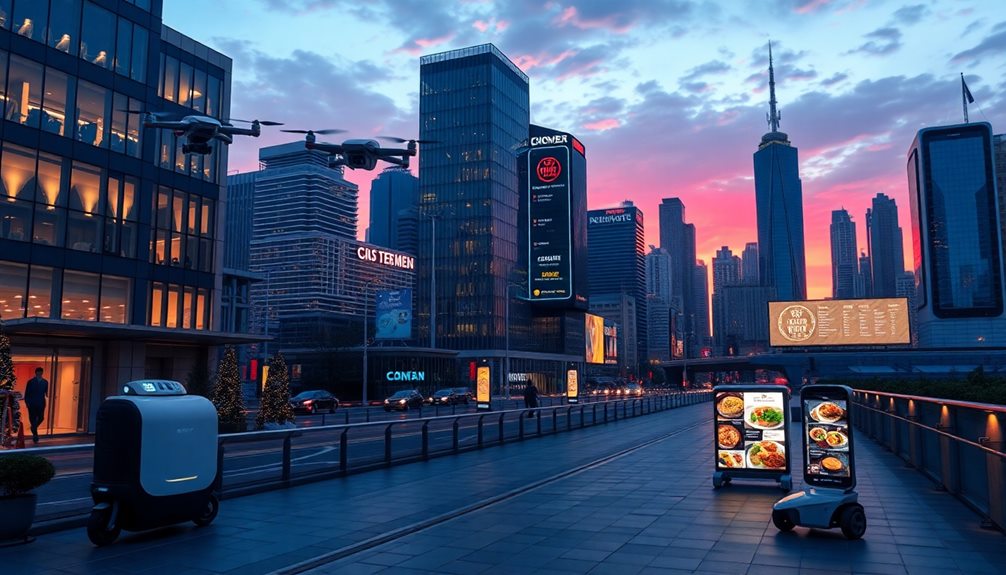
With the food delivery market projected to soar to $42 billion by 2027, the future of delivery services looks promising and full of exciting innovations. You can expect significant advancements that will enhance your online ordering experience.
Autonomous vehicles and drones are being tested to speed up deliveries, ensuring your food arrives fresh and quickly.
Artificial intelligence is also on the rise, offering personalized menu recommendations that cater to your tastes while helping restaurants reduce food waste. As you order your favorite meals, AI can suggest options based on your previous choices, making the process smoother and more enjoyable.
Sustainability is becoming increasingly important in this sector. More restaurants are adopting recyclable and compostable packaging in response to consumer demand, allowing you to enjoy your food guilt-free.
The emergence of ghost kitchens is another trend shaping the landscape, letting restaurants focus on off-premise dining without the overhead of traditional dining spaces.
These trends indicate that the future of delivery services isn't just about convenience—it's about creating a better experience for you, while also being mindful of our planet.
Frequently Asked Questions
Is Food Delivery Declining?
No, food delivery isn't declining. You'll find that many people still order regularly, exploring new options and relying on the convenience it offers. It's a service that's become essential in today's fast-paced life.
What Is the Future of the Food Delivery Market?
The food delivery market's future looks bright. You'll see innovations like drones and AI enhancing convenience. With increasing consumer demand for sustainability and personalization, you can expect faster, eco-friendly options to become the norm.
What Food Delivery Is Used Most?
You'll find that third-party apps dominate food delivery choices, with DoorDash leading the pack. Most people prefer these platforms for their convenience, reflecting a growing trend towards easy and quick meal ordering.
Why Is Food Delivery so Popular Now?
Food delivery's popularity stems from your desire for convenience and variety. With busy lifestyles, you value quick access to meals, making delivery an essential option. Plus, you appreciate the ease of ordering from your favorite places.
Conclusion
As you navigate the ever-evolving landscape of restaurant delivery, it's clear that consumer preferences are driving significant changes. With a growing appetite for convenience and diversity, staying ahead of these trends is key. Whether it's embracing alcohol delivery or optimizing online ordering, you've got to strike while the iron's hot. By understanding customer behavior and adapting to new technologies, you'll position your business for success as delivery services continue to flourish.
